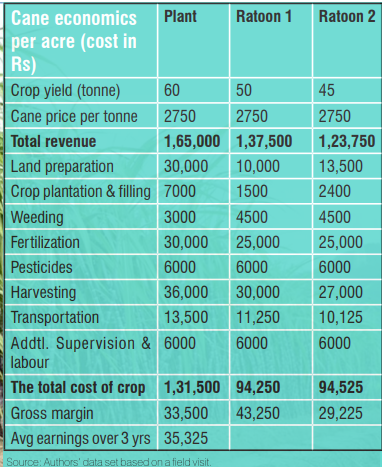In India, sugarcane is an important non-cereal crop contributing to nearly 10 per cent of the total agricultural production in terms of gross area planted. Uttar Pradesh plants nearly 45 per cent of cane in India but its productivity ranks only seventh. Though Tamil Nadu ranks sixth in area under cane cultivation, it tops in productivity as the number one state. To better analyse the vast distinction, the planting practices in Mandya, Karnataka was studied.
The total geographical area of the Mandya district is 498,244 hectare. The crop sown area is 248,825 hectare. The total irrigated area is 116,901 hectare and reservoirs irrigate 104,000. Other sources like tanks, wells and borewells irrigate rest of the land. According to the district statistics, there are 30 rice mills, 4 sugar mills and a number of jaggery making units in the tiny sector.
Mandya is an ideal location for sugarcane farming. However, a recent field visit painted a starkly different picture. The farmers face many challenges that threaten their farming economics and thereby, their livelihood. The cost of inputs such as fertilizers and pesticides are high, while the prices for procured cane are often low. Furthermore, the lack of government support or infrastructure exacerbates the difficulties faced. In light of these concerns, it is clear that more needs to be done to ensure that this vital industry can continue to thrive.
Peer-driven decision-making system
Thanks to the KR dam in Mysore, the Mandya district benefits from a well-designed canal distribution network that spans the length and breadth of the region. The canals are organised into three tiers. The primary canal delivers water directly to the adjacent plots, followed by a valve that distributes water to the next layer of fields. Finally, a third layer is irrigated after the second layer is filled. This three-tier system ensures that every plot receives adequate water, even during drought or low rainfall. Water availability is crucial in determining when and where sugarcane is cultivated in Mandya. Farmers typically wait for the PWD’s announcement that the dam has been filled adequately before planting their crops, usually during late kharif or early rabi. Depending on water availability, they also limit their cultivation to a maximum of two ratoons or replanting. Despite the challenges, the farmers of Mandya still follow the peer-driven system of decision-making, which ensures that contiguous lands are cultivated in a coordinated and sustainable way. While most of Mandya’s sugarcane farmers rely on the canal distribution system, some cultivate in rainfed areas using deep motor wells. Access to reliable power is critical for these farmers in determining their crop choice and they end up investing in expensive diesel generators or risk losing their crops due to insufficient irrigation.
High cost of farming

Limited access to information
The farmers have limited information and monitoring mechanisms to ensure timely harvests. According to them, this is compounded by difficulties in scheduling by mills. Jaggery operations in the area, estimated around 12 per cent of cane produced, is also identified as an impediment. Although jaggery units procure cane from those with inadequate cane quantity for loading or those who missed supplying during the crushing season, it was found inefficient. Farmers who want cash quickly supply to the jaggery unit as it is nearly cash and carry. This results in unreliable supplies for sugar mills. But either way, farmers realise very less.
Without group bargaining power, farmers struggle to appropriate the value they create through their work. This raises the need to ensure fair prices for agricultural products. While some farmers have been able to diversify their income streams by growing tree crops, not everyone could afford to do so. Education and opportunities to move out of the farm sector are also limited.
Across India, cane farmers have a similar story. Downstream products and sugar input are handsomely rewarded while cane farmers are languishing for an appropriate policy or crop alternate.
Authors: Prof Chandrasekaran N, IRMR GSB, Krea University and Prof M Ramasubramaniam, LIBA
